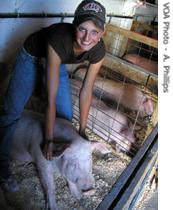-
(单词翻译:双击或拖选)
This is the VOA Special English Agriculture Report.
For Chinese, this is the Year of the Pig. So this is probably as good a time as any to talk about the different kinds of production systems for raising pigs.
| Technician Adam Lewis, left, and support scientist Jeff Dailey connect video equipment to record sow and piglet behavior in a traditional indoor farrowing environment |
The piglets drink milk from the mother sow for three to four weeks, or until they weigh between four and a half and seven kilograms. After they are weaned from their mothers, they are sold.
At another kind of operation, producers raise pigs for about six weeks. When the animals weigh eighteen to twenty-seven kilograms, they are sold to a finish farm.
A third kind of farm is the farrow-to-finish operation. Pigs are born there and stay there. The hogs3 are brought to market when they reach between ninety and one hundred fourteen kilograms.
These three basic production systems used in the United States are described at pork4kids.com, an industry Web site.
Young hogs raised for meat are called feeders. They feed on corn, wheat, soybeans and other grains.
Pigs need protection from heat, cold, rain and snow. Did you know that pigs can get sunburned? They also need enough space to move around easily. Some farmers and activists4 for animals say pigs do better outdoors in a pasture5 or yard than in crowded pens.
 |
| Ann Hutton and her prize pig Lauren |
But producers have to be careful with untreated waste. It can pollute groundwater and cause other environmental and health problems.
To meet demand in the United States, producers keep about sixty million hogs at any one time. Most of these are in operations with more than five thousand pigs.
The world's largest producer of pork is China, followed by Mexico. The United States is third. Pigs provide about twenty-five percent of the American meat supply. About five percent of that is imported. But the United States is also a leading exporter of pork and pork products.
And that's the VOA Special English Agriculture Report, written by Jerilyn Watson. Transcripts7 and audio8 files of our reports are at voaspecialenglish.com. I'm Steve Ember.
 收听单词发音
收听单词发音
1
technician

|
|
| n.技术员,技师 | |
参考例句: |
|
|
|
2
barn

|
|
| n.谷仓,饲料仓,牲口棚 | |
参考例句: |
|
|
|
3
hogs

|
|
| n.(尤指喂肥供食用的)猪( hog的名词复数 );(供食用的)阉公猪;彻底地做某事;自私的或贪婪的人 | |
参考例句: |
|
|
|
4
activists

|
|
| n.(政治活动的)积极分子,活动家( activist的名词复数 ) | |
参考例句: |
|
|
|
5
pasture

|
|
| n.牧场,牲畜饲养 | |
参考例句: |
|
|
|
6
plow

|
|
| n.犁,耕地,犁过的地;v.犁,费力地前进[英]plough | |
参考例句: |
|
|
|
7
transcripts

|
|
| n.抄本( transcript的名词复数 );转写本;文字本;副本 | |
参考例句: |
|
|
|
8
audio

|
|
| n./adj.音频(响)(的);声音(的),听觉(的) | |
参考例句: |
|
|
|















